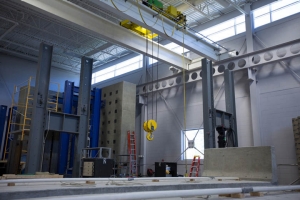ExperienceResearch

Villanova Center for Resilient Water Systems
In June 2018, I joined VCRWS as a graduate research assistant to work on a green infrastructure study funded by PennDOT. Our team is monitoring several sites in the Fishtown neighborhood of Philadelphia, PA that collect stormwater runoff from the newly developed portions of I-95. These rain gardens are intended to capture runoff and allow it to infiltrate into the ground, which helps reduce pollution and increases the groundwater level in the area.
As part of the team, I am responsible for collecting data, monitoring and calibrating the instrumentation, as well as assisting with the design of new monitoring sites. Data is aggregated and stored in a database at Villanova for further analysis. Statistics about inflow volume, ponding depths, soil moisture, outflow volume, and local weather conditions are averaged over 5-minute intervals and collected automatically every 6 hours.
Villanova Structural Engineering
As a research assistant in the Structural Engineering Teaching and Research Lab (SETRL) during my sophomore year, I was responsible for helping a graduate researcher with tasks related to his project, alternative reinforcement materials. In order to reduce the cost of producing precast concrete, we investigated materials that are significantly cheaper than steel but still provide excellent tensile strength and flexural stiffness, namely basalt composites.
Thirty-four eight-foot concrete beams were created with varying reinforcements in multiple configurations and cast in a single pour to avoid possible variances in the concrete composition and strength. After sufficient curing, the beams were prepared for testing by attaching several dozen strain gauges along the length of the beam, as well securing eight roller joints to the top surface to ensure even distribution of the load. Once ready for testing, the beams were positioned underneath a hydraulic actuator with an eight-point loading tree suspended from the bottom. The beams were then loaded until failure and data was recorded about how and where deformation occured for comparison to traditional reinforcement methods as well as other reinforcement configurations.
